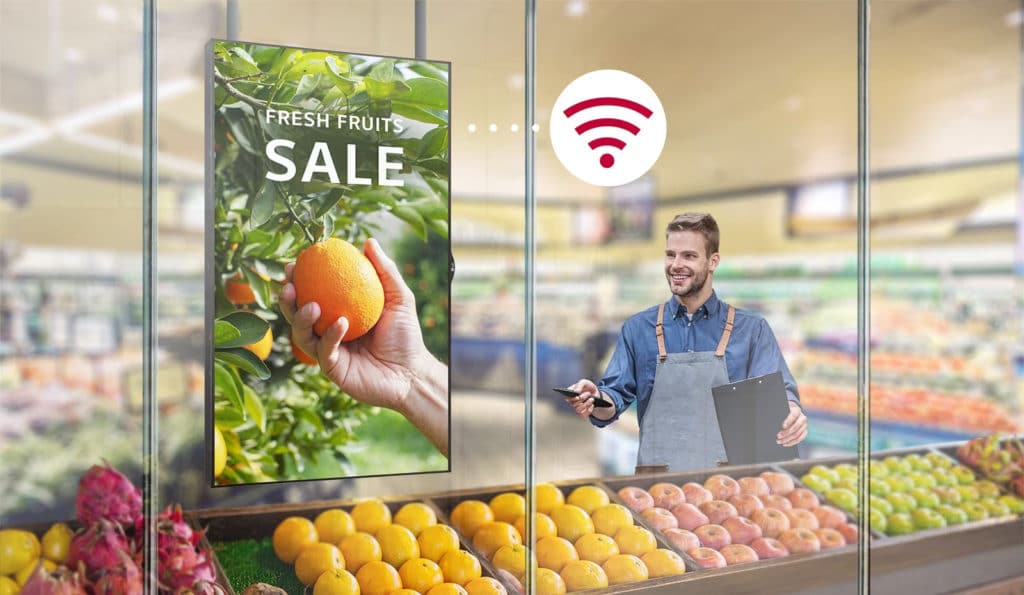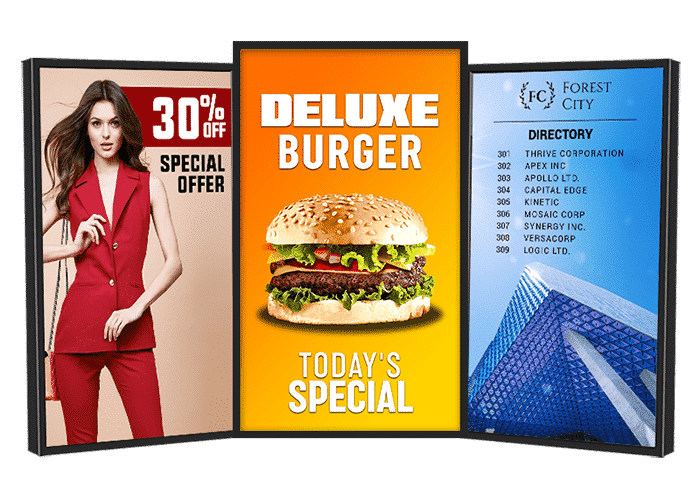Crafting a successful digital signage content strategy is about harmonizing visuals, messages, and timing to resonate with your audience and leave a lasting impression. In this article, we delve into the intricacies of a digital signage content strategy, exploring the key components, best practices, and innovative approaches to captivate, inform, and engage viewers in the ever-evolving landscape of digital communication.

What is a Digital Signage Content Strategy?
A digital signage content strategy is a comprehensive plan that outlines how digital displays will be used to communicate messages, engage audiences, and achieve specific objectives. It outlines what content will be displayed, when and where it will be shown, and how it will be created and managed to effectively reach the target audience.
Another important aspect of this type of content strategy is addressing the goals and objectives of your digital signage, including how you plan to monitor and track your progress. Additionally, it is important to take into account your audience and their preferences as well.

What Makes an Effective Digital Signage Content Strategy?
An effective content strategy prioritizes dynamic visuals that can capture and hold your audiences attention, while effectively delivering your core message. In order to achieve this goal, it is important to carefully consider both your objectives and your audience’s preferences when creating your content. Truly effective campaigns, however, never stop improving their content; once their content goes live, they track its performance and continually make updates over time. In short, find out what works for you and your business, and perfect your approach over time.

Why Use a Content Strategy for Digital Signage?
A content strategy is the next step in optimizing the your digital signage, maximizing your ROI, and truly engaging with your target audience. While such strategies do involve some time and effort, they allow you to effectively deliver timely and dynamic content, all while enhancing the value of your brand as a whole.
Content strategies allow business owners to take complete control of their marketing initiatives, which is one of the main reasons for their widespread use.

How do you Create a Digital Signage Marketing Strategy?
Its no secret that digital signage is ubiquitous in today’s modern world; its on every street corner and in every industry worldwide. While many business owners understand the value of this technology, and even adopt it themselves, actually creating a detailed digital signage content strategy can be more than a little daunting. The next part of this guide is designed to walk you through the main steps of creating your own content strategy.
Define Clear Objectives and Goals
While this may seem obvious to some, it is the essential starting point for any successful campaign. If defining your goals proves to be a challenge, try asking yourself the following question: “what do I want to achieve with my digital signage content?”. In cases where your displays are larger or feature multiple sections, it can help to break it down and consider the objective of each individual section.
The major advantage of having clear goals is that it allows you to measure your success with greater accuracy, while also ensuring you stay focused. When creating and defining your goals, try and remember the S.M.A.R.T acronym!
Specific – Measurable – Attainable – Relevant – Time-Bound.
Establish Your KPIs, or Key Performance Indicators
Key performance indicators are the ways in which you will measure the success of your digital signage content; for example, a promotional display for a restaurant might measure its success by items sold. It is important to not only measure your KPIs, but also record them and reevaluate them over time. When you make a change to your digital signage take note of it, and then check how it has effected your KPIs; if you track your KPIs consistently over time, and experiment with your content, it will allow you to maximize your results.
Understand Your Audience and Customers
In order to effectively capture the attention of your audience, in a world with so much visual stimulus, you need to first understand your audience; understanding your audience is the key to capturing and holding their attention, in other words. We recommend creating an audience profile and including these metrics:
- What is their daily routine?
- What are their interests? (hobbies, values, lifestyle choices, etc)
- What do they dislike?
- What demographics are they apart of? (Age, Gender, location, income level, and occupation)
Tailor Your Content to Your Audience
Once you clearly understand your audience, you need to create content that resonates with them on a personal level. Additionally, when creating content, you should keep both your audience profile as well as your businesses objectives in mind. Essentially, every single piece of content you create should serve a specific purpose, and should also include dynamic visuals whenever possible; examples of dynamic visuals are videos, dynamic eye-catching images, and animations.
Schedule Your Content With Intent and Purpose
When you schedule your content is just as important as what that content is. What exactly does this mean? To put it simply, you should schedule your content when your target demographic is most likely to notice and remember it. This may require some experimentation at first, especially if you are new to targeted content, but keeping track of your relevant KPIS should simplify the process. If you want to get creative, then you can also change the duration of your content depending on your specific needs; while 5-7 seconds is usually recommended, you can lengthen this duration to convey more information at once.
Position Your Screens Strategically to Maximize Intended Viewership
Digital signage should typically be placed in high traffic areas like customer pathways or near checkout counters and waiting rooms. Additionally, it is important to take into account what your content is when you decide on its location. What does this mean? For example, if you are promoting special offers, loyalty programs, or trying to encourage impulse purchases, then placing your displays near your checkout counter can be extremely effective.
Experiment, Experiment, Experiment
Don’t be afraid to experiment with different types of content, screen placement, or even types of visual media – especially if you are tracking your relevant KPI metrics effectively. While this may seem daunting initially it is extremely effective in optimizing your content strategy and getting the best ROI possible for your digital signage. If something is not working, or your circumstances suddenly change, then don’t be afraid to adapt and switch things up.
In Conclusion
In conclusion, creating a digital signage content strategy can be intimidating, but it is much more manageable when you break it down into individual steps. Adapting a well-executed content strategy is key for maximizing the impact of your digital displays and effectively engaging your target audience. By carefully planning, creating, scheduling, and managing content, businesses can leverage digital signage to deliver compelling messages that resonate with viewers and help you achieve your goals.
Related Posts

Sustainable Solutions: How Digital Signage Helps American Businesses Go Green
As sustainability becomes an increasing priority for modern American businesses, many business owners are looking for innovative ways to reduce their carbon footprint and adopt eco-friendly practices. Digital signage offers a compelling

Adapting Digital Signage for Seasonal Campaigns and Holiday Promotions
The holidays are fast approaching, which means many businesses are gearing up for their holiday marketing campaigns, promotions, and initiatives. There are many ways to use digital signage for holiday

5 Ways to Use Outdoor Digital Signage
Outdoor digital signage has become extremely popular in recent years and for a very good reason. This incredible technology has seen numerous advancements that allow it to be a staple

The Future of Outdoor Digital Signage: Weatherproof Displays and Sustainability
The future of outdoor digital signage is increasingly shaped by two key trends: the need for weatherproof displays and the drive toward sustainability. These trends are driven by technological advances,

